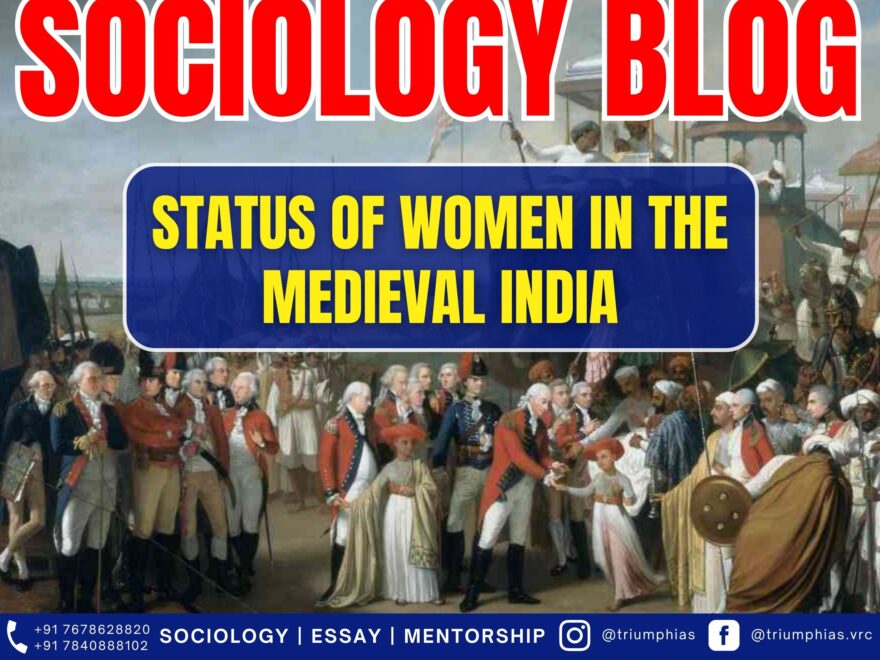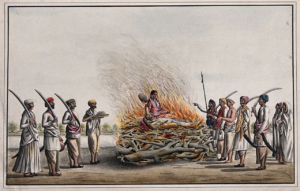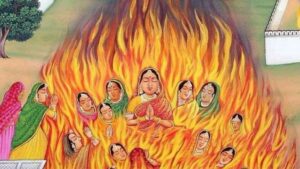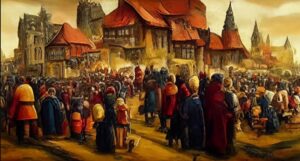Status of women in the Medieval India
Relevance: Mains: G.S paper I: Indian Society; Medieval Indian Women
The Medieval period (Period between 500 A. D to 1500 A.D) proved to be highly disappointing for the Indian women, for their status further deteriorated during this period.
Medieval India was not women’s age it is supposed to be the ‘dark age’ for them. When foreign conquerors like Muslims invaded India they brought with them their own culture. For them women was the sole property of her father, brother or husband and she does not have any will of her own. This type of thinking also crept into the minds of Indian people and they also began to treat their own women like this. One more reason for the decline in women’s status and freedom was that original Indians wanted to shield their women folk from the barbarous Muslim invaders. As polygamy was a norm for these invaders they picked up any women they wanted and kept her in their “harems”. In order to protect them Indian
women started using ‘Purdah’, (a veil), which covers body. Due to this reason their freedom also became affected. They were not allowed to move freely and this lead to the further deterioration of their status. These problems related with women resulted in changed mindset of people. Now they began to consider a girl as misery and a burden, which has to be shielded from the eyes of intruders and needs extra care. Whereas a boy child will not need such extra care and instead will be helpful as an earning hand. Thus a vicious circle started in which women was at the receiving end. All this gave rise to some new evils such as Child Marriage, Sati, Jauhar and restriction on girl education.
Sati:
The ritual of dying at the funeral pyre of the husband is known as “Sati” or “Sahagaman”.
According to some of the Hindu scriptures women dying at the funeral pyre of her husband go straight to heaven so it’s good to practice this ritual. Initially it was not obligatory for the women but if she practiced such a custom she was highly respected by the society. Sati was considered to be the better option than living as a widow as the plight of widows in Hindu society was even worse. Some of the scriptures like ‘Medhatiti’ had different views it say that Sati is like committing suicide so one should avoid this.
Jauhar:
It is also more or less similar to Sati but it is a mass suicide. Jauhar was prevalent in the Rajput societies. In this custom wives immolated themselves while their husband was still alive. When people of Rajput clan became sure that they were going to die at the hands of their enemy then all the women arrange a large pyre and set themselves afire, while their husband used to fight the last decisive battle known as “Shaka”, with the enemy. Thus protecting the sanctity of the women and the whole clan.
Child Marriage:
It was a norm in medieval India. Girls were married off at the age of 8-10. They were not allowed access to education and were treated as the material being. The plight of women can be imagined by one of the shloka of Tulsidas where he writes “Dhol, gawar, shudra, pashu, nari, ye sab tadankeadhikari”. Meaning that animals, illiterates, lower castes and women should be subjected to beating. Thus women were compared with animals and were married off at an early age. The child marriage along with it brought some more problems such as increased birth rate, poor health of women due to repeated child bearing and high mortality rate of women and children.
Restriction on Widow Remarriage:
The condition of widows in medieval India was very bad. They were not treated as human beings and were subjected to a lot of restrictions. In Vijaynagar kingdom women were present in each and every field. Nuniz, another famous traveler to the South also agrees to it and says that women were employed in writing accounts of expenses, recording the affairs of kingdom, which shows that they were educated. There is no evidence of any public school in northern India but according to famous historian IbnBatuta there were 13 schools for girls and 24 for boys in Honavar. There was one major evil present in South India of medieval time. But it was the custom of Devadasis.
Devadasis was a custom prevalent in Southern India. In this system girls were dedicated to temples in the name of gods and goddesses. The girls were then onwards known as ‘Devadasis’ meaning servant of god. These Devadasis were supposed to live the life of celibacy. All the requirements of Devadasis were fulfilled by the grants given to the temples. In temple they used to spend their time in worship of god and by singing and dancing for the god. Some kings used to invite temple dancers to perform at their court for the pleasure of courtiers and thus some Devadasis converted to Rajadasis (palace dancers) prevalent in some tribes of South India like Yellamma cult,(Sharma,2002).

To master these intricacies and fare well in the Sociology Optional Syllabus, aspiring sociologists might benefit from guidance by the Best Sociology Optional Teacher and participation in the Best Sociology Optional Coaching. These avenues provide comprehensive assistance, ensuring a solid understanding of sociology’s diverse methodologies and techniques.
META TAGS:
child marriage, Devadasis, Indian history, INDIAN SOCIETY, Indian women, Jauhar, Medieval India, Purdah, Sati, Union Public Service Commission (UPSC), Widow Remarriage
Why Vikash Ranjan’s Classes for Sociology?
Proper guidance and assistance are required to learn the skill of interlinking current happenings with the conventional topics. VIKASH RANJAN SIR at TRIUMPH IAS guides students according to the Recent Trends of UPSC, making him the Best Sociology Teacher for Sociology Optional UPSC.
At Triumph IAS, the Best Sociology Optional Coaching platform, we not only provide the best study material and applied classes for Sociology for IAS but also conduct regular assignments and class tests to assess candidates’ writing skills and understanding of the subject.
Choose The Best Sociology Optional Teacher for IAS Preparation?
At the beginning of the journey for Civil Services Examination preparation, many students face a pivotal decision – selecting their optional subject. Questions such as “which optional subject is the best?” and “which optional subject is the most scoring?” frequently come to mind. Choosing the right optional subject, like choosing the best sociology optional teacher, is a subjective yet vital step that requires a thoughtful decision based on facts. A misstep in this crucial decision can indeed prove disastrous.
Ever since the exam pattern was revamped in 2013, the UPSC has eliminated the need for a second optional subject. Now, candidates have to choose only one optional subject for the UPSC Mains, which has two papers of 250 marks each. One of the compelling choices for many has been the sociology optional. However, it’s strongly advised to decide on your optional subject for mains well ahead of time to get sufficient time to complete the syllabus. After all, most students score similarly in General Studies Papers; it’s the score in the optional subject & essay that contributes significantly to the final selection.
“A sound strategy does not rely solely on the popular
Opinion of toppers or famous YouTubers cum teachers.”
It requires understanding one’s ability, interest, and the relevance of the subject, not just for the exam but also for life in general. Hence, when selecting the best sociology teacher, one must consider the usefulness of sociology optional coaching in General Studies, Essay, and Personality Test.
The choice of the optional subject should be based on objective criteria, such as the nature, scope, and size of the syllabus, uniformity and stability in the question pattern, relevance of the syllabic content in daily life in society, and the availability of study material and guidance. For example, choosing the best sociology optional coaching can ensure access to top-quality study materials and experienced teachers. Always remember, the approach of the UPSC optional subject differs from your academic studies of subjects. Therefore, before settling for sociology optional, you need to analyze the syllabus, previous years’ pattern, subject requirements (be it ideal, visionary, numerical, conceptual theoretical), and your comfort level with the subject.
This decision marks a critical point in your UPSC – CSE journey, potentially determining your success in a career in IAS/Civil Services. Therefore, it’s crucial to choose wisely, whether it’s the optional subject or the best sociology optional teacher. Always base your decision on accurate facts, and never let your emotional biases guide your choices. After all, the search for the best sociology optional coaching is about finding the perfect fit for your unique academic needs and aspirations.
Follow us :



Find More Blogs…
| Compare and contrast Karl Marx’s and Max weber’s | Karl Marx- Historical Materialism |
| Position of Women In the Modern Indian Society | Sociology: Social system and pattern variables |
For more such notes, Articles, News & Views Join our Telegram Channel.
Click the link below to see the details about the UPSC –Civils courses offered by Triumph IAS. https://triumphias.com/pages-all-courses.php








Exaggeration of the fact that women were free before Turkish invasion. Not to be rude, this essay is devoid of proper facts and sources and self contradictory and blaming everything on the Turks.
Aitareya Brahmana considers “daughter as the source of misery”. In Shatpatha Brahmana it is stated that “women neither owns themselves nor inheritance”
Polygamy was prevalent even before “these invaders”. It is mentioned in Vashistha Dharmasutra that “a Brahmana can have three wives, Kshatriya can have 2 and Vaishya and Shudra can have only one”. It clearly shows that having more wives meant prestige. And obviously was prevalent in the period before the Turks came along.
Can we forget Manu Smriti? How Pathetic the status of women is portrayed in it?
Baudhayana Dharmasutra says a “Father should marry his daughter off to a man devoid of good qualities rather than keep her at home after she attain puberty”.
Again, many of the Dharmasutra and shastras were contradictory to each other.
For example while Niyoga practice was acknowledged by Gautama, it was was considered sinful by Baudhayana.
Also, writer of the essay himself/herself says about Tulsidas’s opinion about women. Was it also due to the Turks as it is claimed in the introduction?
Talking about the Turks, they too brought with them new ideas- for good or for bad. Let’s say, women were hard hit from both the sides. Whilst there were new ideas that came with them, it had nothing dashing to offer for the women folk. Their lives remained miserable.
History is a complex process. There are aspirants out there who are opting for this paper even without having a degree in it. It is your responsibility to genuinely help them.
This website is to help IAS aspirants. Please don’t put up biased, incomplete and misleading readings like this.
While reading the article I made it sure twice whether this article truly belongs to an institution for CSE. Flawed!
Yes, I totally agree with you. History should not be used for biasing of facts.
It is really big misconception about medieval period was brutal for Indian women.. Infact this article is written with lack of research and unauthentic data. Ancient( Manusmirti was there ) Medieval and Modern are never fairly favorable for Indian women.
The take of this article on tulsidas shloka ” dhol ganwar shudra pashu nari shakl tadna ke adhikari” is completely baseless and wrong
If one doesn’t know the context in which the following lines were said then they do not have any right of quoting these lines over here
Firstly go and get your facts correct!